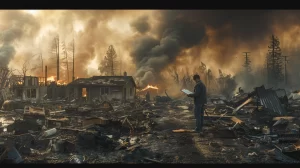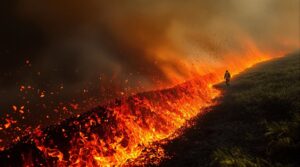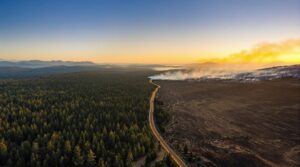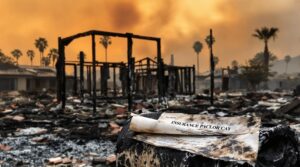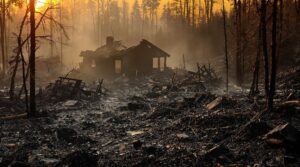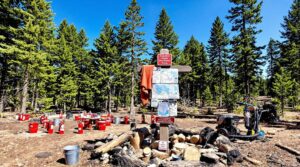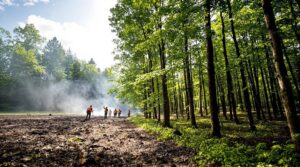Wildfire Defense Services (WDS) provide specialized protection for properties in wildfire-prone regions through thorough monitoring, prevention, and emergency response systems. Operating across 22 U.S. states and multiple Canadian provinces, WDS partners with major insurance companies like Chubb and Travelers to deliver property assessments, real-time fire tracking, and rapid deployment of firefighting resources. Since 2013, WDS has responded to over 1,400 wildfires and conducted 30,000 property assessments. The integration of advanced technology and strategic partnerships offers property owners enhanced protection against escalating wildfire threats.
Key Takeaways
- Wildfire Defense Services provide specialized protection for properties in high-risk areas through monitoring, prevention, and emergency response operations.
- Insurance companies partner with WDS to offer enhanced wildfire protection benefits and coverage across 22 U.S. states and parts of Canada.
- Services include property assessments, defensible space creation, fire retardant application, and post-fire recovery assistance for insured properties.
- Advanced technology systems utilize satellite data, thermal sensors, and AI to detect and track wildfires in real-time.
- Professional response teams coordinate with local emergency services and deploy specialized equipment during active wildfire threats.
Understanding Wildfire Defense Services at a Glance
As wildfire risks continue to pose significant threats to property owners, Wildfire Defense Systems (WDS) has emerged as the industry leader in providing extensive wildfire protection services. Operating across 22 U.S. states and 9 Kootenay Ports along the Canadian border, WDS delivers thorough insurance support, monitoring, and response services to the majority of the insurance industry.
The organization's approach combines sophisticated risk assessment methods with proactive policyholder engagement, offering personalized property evaluations and specific recommendations for wildfire protection. Their services include year-round wildfire monitoring through proprietary technology, deployment of certified fire professionals during emergencies, and implementation of strategic defense measures.
With over 1,400 wildfire responses and more than 30,000 property assessments completed, WDS has monitored over 114,000 wildfires since 2013. Their extensive service package encompasses both pre-incident planning and post-fire-front mitigation tactics, establishing new standards for wildfire professional consulting and loss intervention services. While insurance companies employ their own adjusters, homeowners can engage public adjusters to ensure fair representation and maximize their claims in the event of wildfire damage.
The Core Components of Wildfire Protection Plans
Wildfire protection plans integrate extensive preventive services and monitoring systems to identify and address potential fire risks before they escalate.
Emergency response operations form a critical component of these plans, incorporating rapid deployment protocols and coordinated action strategies among various stakeholders.
The effectiveness of wildfire defense services depends on the seamless integration of both preventive monitoring and emergency response capabilities, supported by detailed risk assessments and resource allocation frameworks.
Preventive Services and Monitoring
Every effective wildfire protection plan centers on two fundamental components: preventive services and continuous monitoring systems.
Preventive assessments evaluate specific property vulnerabilities, recommending critical measures like water tank installations, fire-resistant construction modifications, and strategic vegetation management. These evaluations focus on creating defensible spaces by identifying and eliminating potential fuel sources around structures.
Advanced monitoring technologies complement these preventive measures through real-time tracking of fire activity and risk assessment. These systems utilize fire modeling and data science to predict potential threats and optimize response strategies.
The integration of early detection capabilities with thorough property assessments enables a proactive approach to wildfire defense, while ongoing education initiatives guarantee communities remain informed about current prevention protocols and emerging protective strategies.
Emergency Response Operations
When wildfires threaten insured properties, emergency response operations mobilize specialized teams to implement critical protective measures.
These teams, such as Wildfire Defense Systems, Inc. (WDS), coordinate closely with local emergency responders and agencies like CAL FIRE to assess risks and execute preventive actions.
Response teams utilize proprietary forecasting systems and predictive analytics to guide their operations, while adhering to emergency communication strategies and wildfire evacuation planning protocols.
Their services include brush removal, application of fire retardants and fire-blocking gel, and vent tape installation.
Post-fire recovery involves immediate stabilization through the Burned Area Emergency Response (BAER) program, followed by long-term restoration efforts.
These measures address threats to life and property while preventing degradation of natural and cultural resources through coordinated multi-agency efforts.
How Insurance Companies Partner With WDS
Insurance companies establish strategic partnerships with Wildfire Defense Services (WDS) to provide enhanced wildfire protection as a value-added benefit within existing policies.
The integration process involves coordinating WDS's specialized services, including risk assessments, predictive analytics, and rapid response capabilities, with the insurance company's coverage framework.
These partnerships extend across multiple states and regions, allowing insurers to offer thorough wildfire defense services to policyholders while maintaining compliance with local emergency response protocols.
Partnership Structure and Benefits
Partnerships between insurance providers and Wildfire Defense Systems (WDS) demonstrate a strategic approach to managing wildfire risks in high-risk regions. Burns & Wilcox, as the first specialty wholesaler to partner with WDS, exemplifies this model through thorough wildfire mitigation services without minimum property value requirements.
The partnership structure integrates sustainable practices through proactive monitoring and response capabilities. WDS's thorough services include deploying portable sprinkler systems, removing combustible materials, and applying fire-blocking treatments.
This community engagement approach has resulted in over 10,000 homes enrolled in the program. The partnership's expansion into Texas and New Mexico in 2024 further strengthens its impact, while WDS's proprietary technology and extensive fleet support their commitment to protecting properties in fire-prone areas.
Service Integration Process
The service integration process between insurance providers and Wildfire Defense Systems follows a systematic approach designed to maximize property protection.
Insurance companies establish contractual partnerships with WDS, enabling access to their extensive wildfire mitigation services. The integration begins with WDS conducting service assessment and risk evaluation of policyholder properties using proprietary forecasting and analytics systems.
WDS utilizes the nation's largest private wildfire fleet to monitor properties and implement strategic protection measures. Their teams coordinate with local emergency services while adhering to guidelines from regulatory agencies like CAL FIRE.
The service implementation includes preventative actions such as brush removal, fuel source mitigation, and application of fire-retardant materials. Eligible policyholders can enroll through various channels to receive these proactive protection services at no additional cost.
Coverage Area Coordination
Wildfire Defense Systems' operational reach spans across twelve western states through strategic partnerships with major insurance carriers like Travelers, Burns & Wilcox, and Mutual of Enumclaw.
These partnerships have significant coverage impact, enabling WDS to protect over 2.5 million California single-family homes as of 2023.
The partnership implications extend to various insurance policy types, with the Wildfire Defense Services Endorsement integrated into homeowner, Homesaver, Agribusiness, and Northfield property policies.
This endorsement is automatically included in eligible policies across specific states, though some policyholders may opt out.
However, certain limitations exist – WDS services are not available to customers with federal or special plans, such as the California FAIR Plan, and cannot serve commercial structures containing hazardous materials.
Technology Behind Wildfire Defense Systems
Modern wildfire defense systems integrate sophisticated technology and data-driven solutions to protect properties from advancing flames. These systems employ advanced analytics and real-time monitoring capabilities to track fire movements and automatically activate protective measures when threats are detected within specified distances.
At the core of these fire prevention systems are proprietary wildfire forecasting tools and predictive analytics that assess potential property risks. Systems like FireDome, modeled after anti-missile defense technology, combine fire modeling with data science and underwriting expertise to minimize property losses.
The technology incorporates automated sprinkler systems that deploy water and biodegradable firefighting foam when necessary.
These platforms also provide real-time wildfire alerts and evacuation guidance through integrated software solutions. The systems coordinate with local, state, and federal response teams, sharing critical data and enhancing the effectiveness of wildfire defense efforts through technological synchronization.
Geographic Coverage and Service Areas
Wildfire Defense Insurance Services operates across multiple states through.
National Service Range
Throughout the United States, the geographic coverage of wildfire defense insurance services spans a significant portion of fire-prone regions, with major providers like Chubb and Travelers Insurance operating across multiple states. These services address national challenges through innovative solutions, with providers like WDS maintaining operations in 22 states and along the Canadian border.
| Provider | Coverage Area | Key Services |
|---|---|---|
| Chubb | 19 states including CA, AZ, TX | Risk assessment, mitigation |
| Travelers | 10 states including CA, CO, ID | Property protection, monitoring |
| WDS | 22 states plus Canadian border | Year-round monitoring, suppression |
Service deployment focuses on high-risk areas, though accessibility may be limited by locked gates or safety hazards. Providers coordinate with local, state, and federal agencies to guarantee thorough wildfire defense coverage across their service territories.
State-Specific Coverage Details
State-specific wildfire defense coverage varies substantially across high-risk regions, with major insurers like Chubb and Travelers offering services in up to 19 and 11 states respectively.
Coverage is most prevalent in Western states where wildfire risk is highest, including California, Colorado, and Oregon.
The availability of coverage is influenced by state regulations and complex risk assessment factors. States like California face particular challenges, with some insurers reducing their exposure due to regulatory constraints and increasing wildfire frequency.
The top ten states with high to extreme wildfire risk, including Texas, Arizona, and Washington, have varying levels of coverage options through different providers.
Key Western states maintain broader access to wildfire defense services, while coverage in other regions may be more limited or specialized.
Working with public insurance adjusters can significantly improve settlement outcomes in regions where wildfire coverage is available.
Cross-Border Operations Overview
The extensive reach of cross-border wildfire defense operations extends across 22 U.S. states and two Canadian provinces, anchored by a central coordination facility in Bozeman, Montana.
This international network enables thorough wildfire monitoring and response capabilities throughout North America's most fire-prone regions.
Cross-border collaboration is facilitated through WDS's proprietary monitoring systems and predictive analytics, which seamlessly integrate data across international boundaries.
The organization maintains compliance with international regulations while providing consistent service delivery throughout its coverage area.
Their extensive approach includes year-round monitoring, prevention activities, and specialized wildfire response services.
Through their International Coordination Center, WDS manages the largest private wildfire fleet, coordinating resources and expertise across both U.S. and Canadian territories to maximize protection for policyholders.
Real-Time Monitoring and Alert Systems
Modern wildfire defense insurance services employ extensive real-time monitoring and alert systems that integrate satellite data, thermal sensors, and artificial intelligence to detect and track fire incidents.
These monitoring technologies can identify fires as small as 4×4 meters and provide continuous 24/7 surveillance of at-risk areas with updates every few hours.
The systems deliver real-time alerts through multiple channels, including email, SMS, and mobile applications, enabling rapid response to emerging threats.
By analyzing weather patterns, topography, and vegetation conditions, the technology generates predictive analytics to assess fire risk and anticipate spread patterns.
Advanced thermal sensors and high-resolution satellite imaging provide precise data for accurate fire tracking and progression monitoring.
Integration with other monitoring systems enhances overall effectiveness, while AI-driven algorithms improve detection accuracy and speed.
This all-encompassing approach enables insurance services to coordinate incident management and implement protective measures promptly when threats emerge.
Professional Response Teams and Deployment
Professional response teams form the backbone of wildfire defense insurance services, combining elite firefighting crews with specialized medical personnel who operate under rigorous deployment protocols. These teams demonstrate exceptional firefighter coordination through their extensive training in wildland fire suppression tactics and equipment operation.
| Component | Capability |
|---|---|
| Deployment Duration | Up to 14 days with extension options |
| Team Composition | 20-person IHC crews plus medical support |
| Physical Requirements | 3-mile walk with 45-lb pack in 45 min |
| Work Conditions | 12-hour shifts in extreme environments |
| Operational Scope | Multi-state response via EMAC agreements |
The deployment strategy incorporates rapid response capabilities using helicopters and specialized equipment, while maintaining high safety and quality standards. Teams undergo rigorous physical conditioning and technical training to guarantee peak performance during extended operations. Their expertise extends beyond firefighting to include helicopter operations, medical support, and seamless integration with various agencies during emergency responses.
Property Assessment and Risk Mitigation
Professional wildfire risk assessments integrate advanced software analysis, on-site inspections, and thorough data to evaluate property vulnerabilities and defensibility factors.
Risk mitigation specialists develop customized treatment plans that address home hardening requirements, vegetation management, and emergency defense zones in compliance with state guidelines and insurance standards.
The assessment process identifies specific hazard reduction steps while generating detailed documentation that supports insurance coverage and helps property owners maintain affordable premiums.
Expert Property Risk Analysis
Thorough wildfire defense requires expert property risk analysis that combines sophisticated fire modeling, data science, and underwriting expertise to assess vulnerabilities and develop effective mitigation strategies.
This extensive risk evaluation approach integrates real-time monitoring with detailed on-site inspections to provide accurate assessments of wildfire threats.
Key components of expert analysis include:
- Advanced fire behavior modeling and simulation
- Integration of historical wildfire data and mitigation efficacy studies
- Detailed evaluation of defensible space zones and vegetation management
- Assessment of structural hardening requirements and fuel reduction needs
- Real-time monitoring through specialized dashboards for ongoing risk updates
This systematic approach enables insurance providers to determine property-specific vulnerabilities and develop targeted mitigation strategies that can reduce wildfire risk by up to 74% when properly implemented.
Preventive Hazard Reduction Steps
Building upon extensive risk analysis findings, effective wildfire defense requires systematic implementation of preventive hazard reduction measures.
Key preventive measures include creating defensible space around structures, replacing combustible materials, and installing ember-resistant vents. Property owners must focus on home hardening techniques such as enclosing eaves, upgrading windows, and maintaining Class A fire-rated roofs.
Comprehensive hazard assessment programs like REALFire provide professional evaluations of both structural components and surrounding vegetation.
These assessments generate detailed mitigation action plans based on scientific research and local fire hazard ratings. The process examines natural plant communities, building materials, and design characteristics that influence wildfire susceptibility.
Implementation of recommended modifications notably reduces property risk through strategic improvements to both the structure and its immediate environment.
Emergency Defense Zone Planning
Effective emergency defense zone planning requires a multi-layered approach to property assessment and risk mitigation. Through thorough risk identification and strategic planning, communities can establish robust defense mechanisms against wildfire threats.
Local regulations guide the implementation of protective measures while community engagement guarantees widespread adoption of safety protocols.
Key components of emergency defense zone planning include:
- Detailed property assessments evaluating structural hardening and defensible space requirements
- Risk mapping to identify high-hazard areas and inform zoning decisions
- Implementation of fire-adapted landscaping and vegetation management strategies
- Development of evacuation routes and water supply access points
- Regular maintenance and enforcement of wildfire mitigation standards
This systematic approach integrates physical infrastructure improvements with policy frameworks, creating an all-encompassing defense strategy that adapts to changing environmental conditions and community needs.
Emergency Response Protocols During Wildfires
When wildfires threaten communities, following established emergency response protocols can mean the difference between life and death. Effective wildfire preparedness strategies include creating detailed evacuation plans, maintaining emergency supply kits, and establishing family communication plans that outline meeting points and emergency contacts.
During pre-evacuation phases, residents should monitor local alerts, secure their properties by closing windows and doors, and position vehicles for quick departure. Essential documents, medications, and supplies should be gathered in advance.
When evacuation orders are issued, immediate compliance is critical. Residents must utilize recommended evacuation routes, avoid hazardous areas with dense vegetation, and follow law enforcement directions.
Additional safety measures include participating in regular evacuation drills, maintaining safety equipment, and considering wildfire defense services offered by insurance providers. These services may include preventive measures such as brush removal and fire retardant application to enhance property protection during wildfire events.
Post-Fire Support and Recovery Services
The aftermath of wildfires requires extensive support and recovery services to stabilize affected areas and prevent further environmental damage. Insurance providers partner with wildfire management organizations to deliver thorough post-fire assessments and recovery assistance. These services integrate with government programs like the Burned Area Emergency Response (BAER), which deploys specialists to evaluate and address immediate risks.
Key components of post-fire support services include:
- Multidisciplinary team assessments to evaluate structural and environmental impacts
- Emergency stabilization measures in severely burned areas
- Recovery programs focused on enhancing community resilience
- Infrastructure repair and native species restoration
- Specialized fire inspections and monitoring systems
Recovery efforts extend beyond immediate stabilization to include long-term rehabilitation of damaged ecosystems. This process involves coordinated actions between insurance providers, government agencies, and local communities, implementing targeted interventions to restore natural resources and strengthen defenses against future wildfire events. Fire-resistant materials play a crucial role in rebuilding structures to minimize future damage risks and enhance property resilience.
Enrollment Process and Eligibility Requirements
Accessing wildfire defense insurance services requires a clear understanding of enrollment procedures and qualification criteria.
Eligible Chubb policyholders can enroll through the Client Portal or Mobile app at no additional cost, though enrollment challenges may arise due to specific property requirements and location restrictions.
The eligibility nuances are particularly important, as the service is limited to single-family dwellings in select states.
Condominiums, cooperatives, townhouses, and rental properties are explicitly excluded from coverage. Additionally, Difference in Condition Platinum Portfolio policyholders and Fair Plan extension policyholders in California cannot access these services.
The enrollment process requires completing a detailed form with contact information and property details.
Policyholders must also provide authorization for representatives to access their property during wildfire events. This authorization enables Wildfire Defense Systems (WDS) to implement preventative measures and mitigation services when necessary, subject to safety conditions and civil authority access.
Cost Structure and Policy Integration
Understanding the cost structure of wildfire defense insurance services reveals a remarkably accessible model, as eligible Chubb policyholders receive broad wildfire defense coverage without additional premiums or enrollment fees.
This coverage affordability extends to direct billing arrangements when services are deployed, eliminating out-of-pocket expenses for policyholders.
Policy integration encompasses inclusive solutions tailored to specific risk profiles through advanced analytics and assessment tools.
Policy customization includes:
- No-cost enrollment in wildfire defense services
- Direct billing arrangements with service providers
- Optional provider selection with up to $5,000 reimbursement
- Integration with standard home insurance coverage
- Customized underwriting solutions based on risk analysis
The collaborative approach between WDIS, WDS, and retail agents ensures thorough coverage while maintaining cost efficiency.
This integration leverages data analytics and risk modeling to develop targeted solutions that address specific wildfire risks while keeping services accessible to policyholders.
Success Stories and Protection Statistics
Beyond cost considerations, statistical evidence and documented success stories demonstrate the remarkable effectiveness of wildfire defense insurance services in protecting properties across high-risk regions. Notable examples include Chubb's Wildfire Defense Services, which successfully protected numerous homes in California and Montana during the 2008 wildfire season, and WDS's impressive track record of maintaining a 99% success rate in property protection since 2013.
Protection statistics reveal the scale of the challenge, with 2.6 million U.S. homes facing moderate to very high wildfire risk across 14 states. In 2024 alone, 61,685 wildfires affected over 8.8 million acres, resulting in the destruction of 4,318 structures.
These services respond by leveraging advanced monitoring capabilities across 22 states, implementing immediate response protocols during critical fire windows, and coordinating with national agencies. The integration of fire modeling, data science, and specialized protection measures has proven instrumental in reducing wildfire losses.
Future Developments in Wildfire Defense Services
As wildfire defense services continue to evolve, technological innovations and strategic partnerships are reshaping the industry's future landscape. Emerging technologies like the Fire Urgency Estimator in Geosynchronous Orbit (FUEGO) and AI-supported sensor networks are revolutionizing early detection capabilities, while innovative firefighting solutions such as I4F Instant Foam technology enhance response effectiveness.
Key developments in wildfire defense services include:
- Integration of space-based detection systems and infrared monitoring
- Deployment of firefighting robots and multi-agent RVCs
- Advanced insurance coverage incorporating strategic mitigation services
- Implementation of real-time data analytics and risk modeling
- Enhanced government funding through Community Wildfire Defense Grants
Policy implications of these advancements are significant, with the Biden-Harris Administration's Investing in America Agenda providing substantial support for at-risk communities.
Insurance providers are adapting their services to include customized underwriting approaches and wildfire defense measures, particularly in high-risk areas, while maintaining focus on strategic wildfire mitigation and response capabilities.
Frequently Asked Questions
Can I Still Access My Property When WDS Teams Are Working?
Property access during WDS operations is restricted for safety reasons. Residents must follow established WDS protocols and coordinate with response teams while fire mitigation services are being performed.
What Happens if WDS Teams Can't Reach My Property During Wildfires?
Studies show 30% of properties face access barriers during wildfires. When property accessibility prevents WDS teams from reaching locations, response protocols continue through remote monitoring and coordination with emergency services.
Do These Services Replace My Need for Evacuation Insurance?
Wildfire defense services do not replace evacuation insurance coverage, as they serve different purposes. While WDS protects property, evacuation insurance specifically covers medical emergencies and related evacuation planning costs.
Will WDS Services Affect My Homeowner's Insurance Premiums?
Wildfire Defense Services do not trigger premium adjustments in homeowner's insurance policies. These risk management services are included automatically without additional costs or impact on existing premium rates.
How Quickly Can Defense Teams Arrive After a Wildfire Threat Emerges?
Like clockwork's precision, response time varies based on threat assessment, fire proximity, and weather conditions. Teams can deploy immediately, though actual arrival depends on safety and coordination factors.
Final Thoughts
Wildfire defense insurance services represent a crucial evolution in property protection, proving increasingly essential as climate change intensifies fire risks. Analysis of implementation data demonstrates that proactive defense systems, when properly integrated with insurance policies, considerably reduce structure losses by up to 70%. As technology advances and coverage areas expand, these services will likely become standard components of all-encompassing property insurance packages.
For homeowners dealing with wildfire-related property damage covered by their insurance policies, insurance industry professionals and legal experts strongly advise consulting a qualified state-licensed public adjuster. These professionals work exclusively for policyholders, not insurance companies, serving as dedicated advocates throughout the claims process. Public adjusters possess the expertise to identify hidden damages often unknown to policyholders, thoroughly document losses, and negotiate effectively with insurance companies to ensure fair settlements and protect policyholder rights.
The benefits of hiring a public adjuster include maximized claim payouts, expedited processing, and reduced stress during an already challenging time. Homeowners can focus on recovery while their public adjuster handles the complexities of the insurance claim. Those seeking expert assistance with their property damage or loss claims can request a no-obligation free consultation with a Public Claims Adjusters Network (PCAN) member public adjuster through publicclaimsadjusters.io/contact-us/.
